Wild Garlic Impostors!
15th March 2021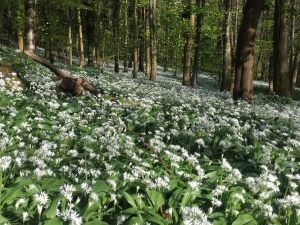
The flowers of wild garlic can turn the woodland floor white and green in spring.
It’s that wonderful time of the year, late winter and into early spring when the heady aroma of wild garlic starts to permeate the woods and valleys of the UK. The days are getting longer, the birds are singing from dawn to dusk, and green shoots are sprouting in all corners, especially in the woods. It is that short period in the year that sunshine is illuminating the forest floor, bathing the ground in life giving warmth and photosynthetic stimulation.
For a few months before the trees gain their leaves blocking out the sun, the plants around their feet have a chance to sprout, flower, and spread. That may be through seeds, bulbs, or rhizomes, whatever way, they are in a race to spread, competing with all comers to dominate an area and produce more progeny, improving their gene’s chances of survival.
We witness these battles for survival in the stunning bluebell and wild garlic woods, sheets of blue or white often as far as the eye can see, knowing that by mid-year depending on where you are these spectacles will wither away into a soggy green mess, returning all the nutrients to the soil.
Wild garlic is one of our staples as foragers, going into pestos, salad, soups, tarts, even the buds and flowers being pickled to keep us going through the
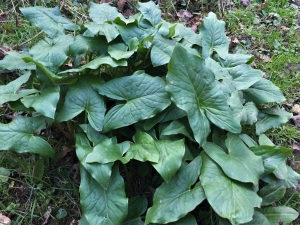
Mature Lords and Ladies
year.
It is one of the safest things to forage for, but this lush and special plant does have other plants growing in and around it that if eaten would spoil your day, possibly permanently! So let’s have a look at three other plants that could be mistaken for wild garlic that grow in the spring time, in the same places.
Lords and Ladies
Arum maculatum is the scientific name for this one, ‘Arum’ telling us it is a member of the Lily family, and it has spots, ‘maculatum’. It has many common names in the UK, Lords-and-Ladies, Cuckoo-Pint, Snakeshead, Adder’s Root, and many more spread across its range through Europe.
It appears at just the same time as the wild garlic and in the same damp woods, more often than not happily mixed in with swathes of wild garlic, can you spot the lords and ladies in the picture at the top of the article? It’s green leaves in clumps happily camouflage it, and although its scientific name
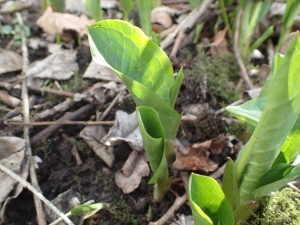
Lords and Ladies leaves unfurling
alludes to spots, those black spots on the leaves occur less than 50% of the time.
The leaves start off at 3cm or so and oval, soon becoming arrow shaped with rounded tails and up to 30cm long. Later in the season a separate stem with a cowl like flower emerges, the stamen being a single finger like appendage inside. The flower soon dies away leaving the stamen with developing green seed pods looking a bit like corn on the cob.
The seeds soon turn bright red and this is when they tend to be noticed through the summer and into the autumn. At that stage no-one is going to mistake them for anything edible, however in the spring the leaves could easily be picked by the enthusiastic wild garlic picker grabbing handfuls in haste.
Alas the Lords and Ladies would soon make its presence felt in any dish, as soon as the unwary forager bit down on the unwanted leaves, needle like crystals of calcium oxalate would be released piercing the soft moist flesh. This is often described as like having a mouthful of paper cuts, and is
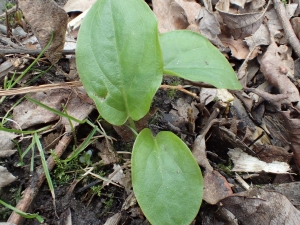
Young Lords and Ladies leaves already developing the rounded ‘tails’ at the base of the leaf
followed by painful blistering, not the experience any forager would want to inflict on their dinner guests!
So the moral of the story is check every handful of wild garlic leaves you pick, for hiding amongst the pungent masses maybe some lords and ladies leaves, not a guest you want for dinner.
Make sure that none of the leaves you collect have the characteristic ‘tails’ of lords and ladies. Garlic leaves are always smooth and oval leaves.
There is also a white veined version of this plant called Arum italicum. This is often used as an ornamental plant in garden flower beds and is equally irritating.
For more details have a look at lords and ladies in our online hedgerow guide
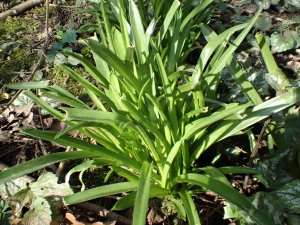
Bluebell leaves
Bluebells
Bluebells, a seemingly quintessential British (we do have over 50% of the worlds population of Hyacynthoides non-scripta, the English or
British bluebell) sign of spring, lorded on National Trust websites, ‘visit our bluebell woods’, and truly a breathtaking site but also a risk to foragers. This splendid little plant is also toxic, the leaves the bulb, the flowers and stems all contain toxic glycosides. Consuming some would cause a stomach upset, and in a large quantity possibly death.
Now no one is going to mix up blue flowered bluebells and white flowered wild garlic when in flower, but by dint of the fact that they occupy those same damp woods and come up at the same time as soon as winters grip starts to wain, they might just be mistaken for wild garlic. The fact that the slender green leaves don’t look like wild garlic should be a clue, and don’t smell like wild garlic should seal the deal.
The only part that does resemble wild garlic is the bulb, but then you should not be digging up wild garlic bulbs because the garlicy bits are all above ground and digging up any plant on public access land is prohibited under the 1981 Wildlife and Countryside Act.
Lily of the Valley
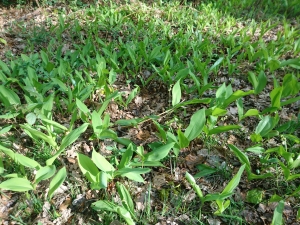
Lily of the valley
Ahh, lily of the valley, a very fashionable fragrance from the 1930’s onwards being imitated in such classic perfumes as Diorissimo by Dior. The national flower of Finland and the former Yugoslavia, it is a favourite at weddings, including the Duchess of Cambridge’s bridal bouquet. Alas despite its beauty lily of the valley has a dark secret, it is full of potentially deadly heartbeat altering glycosides, around 38 all told. Consumption of any part foe the plant could lead to heart arrythmias requiring urgent medical treatment.
Both lily of the valley and wild garlic grow in damp woodland, they grow in clumps, up to a few metres in diameter for lily of the valley and up to hundreds of metres for wild garlic. They both have white flowers, lily of the valley has bells hanging down from nodding stems similar to bluebells, wild garlic has umbels of white star shaped flowers held up above the stems like small fireworks.
The leaves of both plants are flat, smooth, shield shapes with longitudinal veins from 5 to 15cm long. Lily of the valley leaves a little more matte, a bit wider and tougher, but at a glance they are quite similar. Wild garlic appears in late February, flowers through March and April and is all but over by June (August in Scotlands), lily of the valley is later, appearing in April, flowering in May, and dying back in August. So there is considerable overlap in
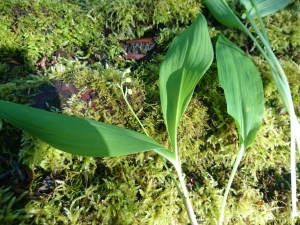
Two leaves on the Lily of the valley stem on the left and one on the wild garlic on the right
their timings, however, do not fear as a careful look and a good sniff are all that is needed to tell these two plants apart.
Although often found in adjacent patches and commonly throughout the UK the two plants have two distinct differences. Wild Garlic only ever has one leaf on each stem, Lily of the Valley has two. They both appear en mass so there should always be plenty of specimens to check.
Then it all comes back to the key identifier for wild garlic – it smells of garlic! Give the leaf a good rub to release the fragrance on a cold and blustery day and put it right under your nose and inhale. All but those with severe anosmia (loss of sense of smell) will be able to smell the garlic. If you can’t then it is either not wild garlic or you can’t smell it. In either case be cautious and maybe get someone else to smell it or give it a miss. Lily of the valley is a very seriously poisonous plant and ingestion can be fatal, so you need to be certain about what you are picking for the pot.
For more details on lily of the valley have a look at our hedgerow guide here

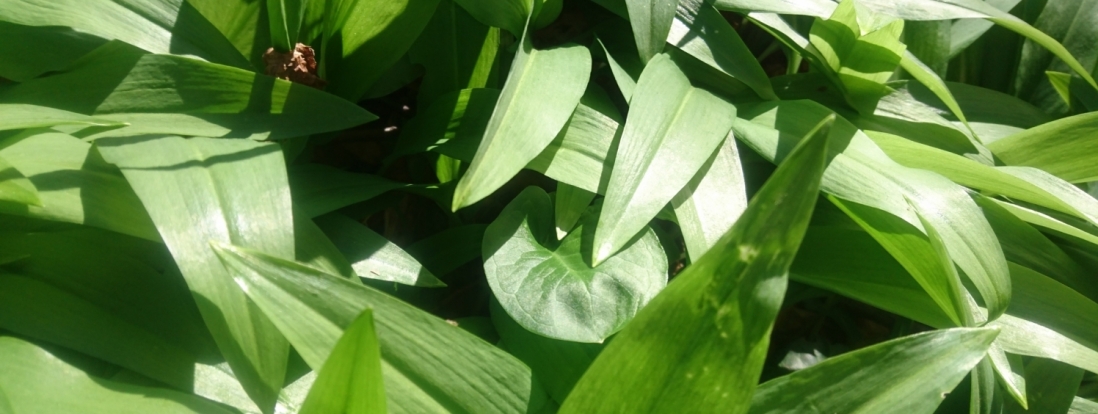



8 comments for Wild Garlic Impostors!
Our garden has a stream running through it, and swathes of ramsons (can we reclaim the old word, if only because it’s a satisfying false double plural) in Spring. They grow up through forests of snowdrops. I think snowdrops are poisonous? Their presence puts me off harvesting the ramsons. Am I being a wimp?
Snowdrops are poisonous but the leaves are much thinner than those of Ramsons and they don’t smell strongly of garlic. I would harvest them, just pay attention to what you are gathering.
I spent many backbreaking hours last year trying to rid my garden of wild garlic. I have no idea how it got there in the first place, and I didn’t mind it initially when there were just a few plants but it multiplies like wildfire and was taking over the garden. A few have come up this year but I’ll be getting rid of those.
I don’t even like garlic, in fact I can’t stand the stuff! (Though I do like onions).
Oh please, at least give it to someone who will appreciate it! It’s great for all sorts or roughly chopped and added to mayonnaise.
I have a white belled plant with long slender leaves ,identical in form to bluebells but white. It smells like very mild garlic and the bulbs look very like a tiny garlic bulb. It grows all along the country lane behind our house and smells lovely if you step on it.
I always though it was wild garlic,but am reluctant to try it if it could be poisonous.
Can anyone enlighten me as to whether it is edible or toxic please?
It sounds like few flowered garlic which you can find in our guide. You can send photos of it to [email protected] and we will try to confirm an ID. In the UK, if it smells of onion or garlic it is most likely in the Allium family and is edible.
i’ve recently had the dead leaves from last year’s montbretia flowers cut down. Since then, there has been a slight garlic smell coming from the border where the flowers grow. Snowdrop shoots were accidently cut at the same time. could it be possible that this has anything to do with the smell? its not very pleasant when stepping from my back door. Wondering if cutting has released an odour. I’m baffled as Its never happened before. Thank you.
Montbretia does have a smell that is described as like saffron which gets stronger with age, maybe when they get old they smell a bit garlicky. The only other thing to try would be to cut a snowdrop leaf and smell that, they don’t smell of much but if you get a strong garlic smell they may be the similar looking three cornered leek or few flowered garlic.